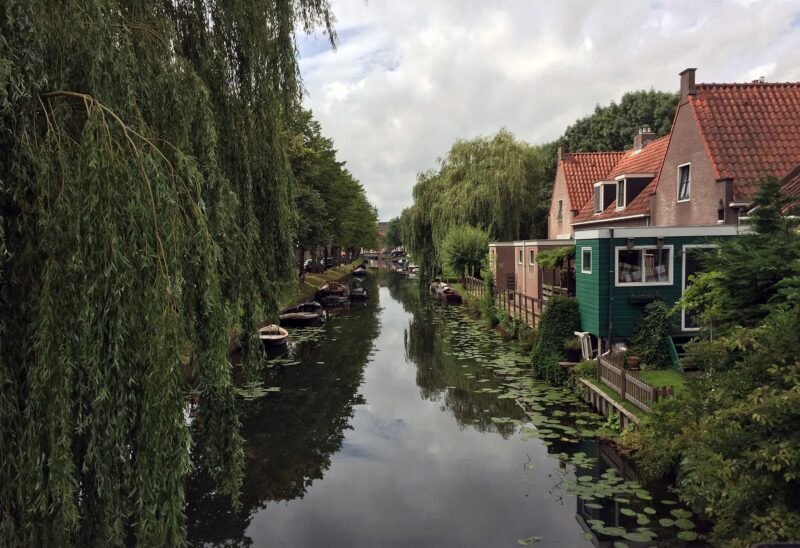Edam
- The Great Church
The Great Church, dedicated to St. Nicholas, patron saint of boatmen and sailors, was built in the early 15th century as a cruciform church, the nave of which had narrow side aisles. Towards the end of the 15th century, the side aisles of the nave were widened to form a hall church. In the early 16th century, the chancel, which was of modest size, was demolished and replaced by the present expansive chancel. A short time later the libary was built on. Like many churches, this church was ravaged by fire. This was in 1602. Immediately after the disaster the restoration was started. On that occasion the church received new windows, for which many people donated beautiful stained glass windows, 31 in number, which can compete with the famous glasses of Gouda. The organ was built in 1662-1663 by Barent Smit, organist and organ builder in Hoorn. After restoration begun in 1962, the repairs were completed on April 25, 1979 with the official re-inauguration.
- The Proveniershofje and the Orphanage
The Proveniershofje, dating from 1555 is located opposite the Great Church. On the same spot there were the beguinages before 1555. These beguines taught the youth of Edam and nursed the sick. A few years ago a thorough renovation took place and now the hofje is inhabited by elderly people. In 1558, more than 400 years ago, the priest Matthias Tynicy Matthiasz, whose name still lives on in the Matthijs Tinxgracht, founded the orphanage on Grote Kerkstraat, in which building in the mid-eighties the municipal social service was housed. As the building looked before the renovation at the end of 1700, it is hardly recognizable now, but the old colored facade stone, framed by a fake Greek temple, still adorns the facade. It depicts orphan boys playing pommel horse. Above the gate on the side of the Matthijs Tinxgracht two orphans are depicted in attire, which can still be found in Frisian towns.
- Play tower
The Speeltoren is a remnant of the Onze Lieve Vrouwe- or Kleine Kerk, which was demolished in 1883 and dated from the 15th century.
The Kleine Kerk was a late Gothic building, with two equally high naves.
Due to neglect, this monument had suffered so much that only the part adjoining the tower could be preserved.
- De Kwakelburg
The Kwakel bridge at the end of the Schepenmakersdijk – a favourite subject for painters, draughtsmen and photographers – is one of the few remaining seesaw bridges with one sprit.
A yoke splits the hanging chain into two parts, to which the clap is attached.
This bridge is already very old and appears on the famous Edam map by Johan Blaeu.
- The Mill
The Mill on the Broekgouw (an octagonal indoor windmill), with a flight of 22 meters, was most likely erected in the 17th century. The body and the cap are covered with reeds. It used to drain the Zuidpolder.
Not being able to sum up everything in a nutshell, it is recommended that you take a walk through Edam.
You will notice that here, in the bustling present, an atmosphere of the old has remained alive, which is unique and difficult to describe.
- Old Wooden House
On the corner of the Eilandsgracht and the Breestraat stands the “oldest wooden house” of Edam.
Very special is the fact that this house managed to survive the many city fires that also ravaged Edam. The building is an extremely rare example of Gothic timber construction in the Netherlands and was probably built around 1530. An indication of this is the door calf, decorated with a low-Gothic arcade arch and rosettes.
With the exception of the later built stone back room, it is an entirely wooden house, of which the front facade with its up and down folding shutters, is still almost entirely original. Even the door with the beautiful lock probably dates from the earliest construction period. The house was thoroughly restored around 1980.
- Mansion
At the end of the Schepenmakersdijk, behind a wooden fence, stands ‘the Gemeenlandshuis’, from 1785. It consists of three buildings from the 18th century grouped around a court. Until recently the house was used as an office for the Water Board. A different use is now being sought for it.
The courtyard looks colorful with the paths of yellow and purple stones, the bright red geraniums and the garden statues placed on pedestals, representing the seasons. This courtyard is well worth a visit.
